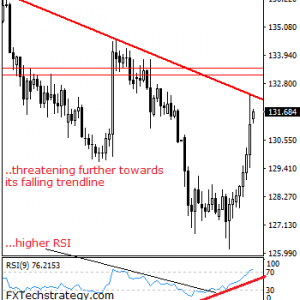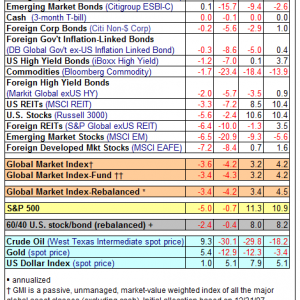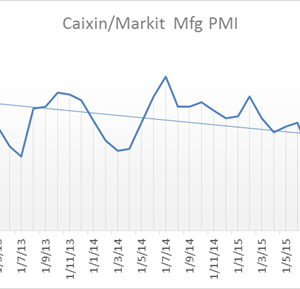Latest Posts
-
Finance 0
EUR/JPY Sees Bull Pressure But With Caution
EURJPY: Having rallied strongly the past week, we envisage further strength to occur. However, with almost a half of that rally taken back, a correction could be developing ahead of its medium term falling trendline (red). Support comes in at the 131.00 level where a break will aim at the 130.50 level. A turn below here will target the 130.00 level with a breach turning focus to the 129.50 level. Conversely, resistance lies at the 132.00 level. Further out, resistance comes in at the 132.50 level where a break if seen will threaten further upside towards the 133.00. Further out, resistance resides at the 133.50 level. All in all, the cross re...On February 1, 2016 / By Kurt Osterberg -
Finance 0
Major Asset Classes – January 2016: Performance Review
The risk-off trade continued to weigh on the major asset classes in January. The main exception: several slices of high-quality bonds popped last month, led by the 1.5% total return for inflation-indexed US Treasuries. But the bulk of performance data was skewed to the downside in the kick-off month for 2016. January’s big loser: foreign developed-market stocks (MSCI EAFE), which slumped a hefty 7.2%. US stocks did better, but only in relative terms. The Russell 3000 tumbled 5.6% last month and is now off by more than 2% for the trailing one-year period through the end of January. Diversification across asset classes is providing a degree o...On February 1, 2016 / By Kurt Osterberg -
Finance 0
EUR/GBP Rebound Limited In Scope
Although the Euro has managed to gain ground in recent weeks amid positive fundamental signs and show other improvements in economic metrics, the pressure on the Pound has been unrelenting due to mounting negative reports from the United Kingdom’s Office for National Statistics. However, while the Pound has been beaten up over the last few months, there are several far-reaching factors that could quickly reverse that momentum. With an impending decision from the Bank of England Monetary Policy Committee rapidly approaching and speculation of expanded asset purchases from the European Central Bank gaining traction, the Euro may soon find ...On February 1, 2016 / By Kurt Osterberg -
Finance 0
Forex Week In Review – 2/1/2016
Last week saw all of the major markets regain some ground and the oil price consolidate earlier gains. Friday marked the final trading session for January, so it is a convenient point to look back over the fortunes of the month. In Europe over the course of the week, the FTSE was up by 3.1%, it closed at 6083.8, but fell by 2.5% on the month; the Dax ended at 9798.1, up by 0.34% on last week’s close, but falling by 8.8% in January; the CAC was up by 1.9% to end the session at 4417, but it slipped by 4.8% over the month. The Dow ended the week up by 2.3% to close at 16466, however, it lost 5.5% in January. The Nasdaq composite index ended up...On February 1, 2016 / By Kurt Osterberg -
Finance 0
Dollar Mixed To Start The Week
Investors continue wrestling with the implications of last week’s surprise rate cut by the Bank of Japan. The yen is little changed against the dollar, near its 200-day moving average (~JPY121.50). The euro moved from the upper end of its two-cent range last Thursday to the lower end on before the week. The absence of follow through selling appears to have prompted some short-covering. The $1.0880-$1.09 area may stymie the upside. Softer Chinese data and a pullback in oil prices are weighing on the dollar-bloc currencies. The Canadian dollar is the weakest of the majors, losing a little more than 0.5%. The Australian and New Zea...On February 1, 2016 / By Kurt Osterberg -
Finance 0
Lackluster China PMIs Pressure Copper, Oil While Gold Advances
China Caixin Manufacturing Purchasing manager index (PMI) compiled by Markit showed a slight improvement in January, at 48.4 versus 48.1 expected and 48.2 prior. This survey-based, forward looking index offers a good gauge of factory activities, therefore of the Chinese economy. Both Caixin and official data highlighted deteriorating conditions as PMI remained below the 50 division figure (between contraction and expansion), last seen in February 2015. The upcoming Golden Week in celebration of Lunar New Year could provide a relief from yuan depreciation and stock market rout. Copper price halted its 1.18 percent intraday declines due to sof...On February 1, 2016 / By Kurt Osterberg -
Finance 0
When Comfort Blankets Go Bad: Risk, Perception And Investing Theater
Investing as Performance Art The security analyst Bruce Schneier describes many of the security measures on public display as “security theater”: a meaningless set of rituals designed to provide a comfort blanket. He argues that these measures provide no useful protection and mainly serve to make our lives more difficult, increasing the risks we have to take while simultaneously restricting our freedoms. I’d argue that much of the performance art we see around investing serves much the same purpose – and with much the same outcome. Box ticking regulations don’t actually do much for investors other than make their lives mor...On February 1, 2016 / By Kurt Osterberg -
Finance 0
EUR/USD Forex Signal For February 1, 2016
EUR/USD Signal Update Last Thursday’s signals expired without being triggered. Today’s EUR/USD Signals Risk 0.75% Trades may only be entered between 8am and 5pm London time today. Long Trade 1 * Go long following a bullish price action reversal on the H1 time frame immediately upon the next touch of 1.0772. * Place the stop loss 1 pip below the local swing low. * Move the stop loss to break even once the trade is 20 pips in profit. * Take off 50% of the position as profit when the price reaches 20 pips in profit and leave the remainder of the position to ride. Long Trade 2 * Go long following a bullish price action reversal on the H1 tim...On February 1, 2016 / By Kurt Osterberg -
Finance 0
The Fed Is Not Hiking: Risk Assets To Perform
The landscape of global monetary policy is changing. In late 2015 we had the Fed hiking, signalling more to come, the ECB holding back on fresh QE and even the BOJ, which has engaged in more easing than any other central bank in history, was sitting on its hands. That tune has changed. The BoJ moved to negative rates this week. The Fed didn’t hike and signalled that they aren’t going to hike in the short term. The ECB is making noises about expanding its QE programs. In this article we explore direction of monetary policy going forward and its implications for financial markets. The Fed Was Dovish This Week This week the FOMC statement wa...On February 1, 2016 / By Kurt Osterberg -
Finance 0
5 Undervalued Companies For Enterprising Investors Near 52 Week Lows – January 2016
There are a number of great companies in the market today. By using the ModernGraham Valuation Model, I’ve selected the five undervalued companies reviewed by ModernGraham trading closest to their 52 week low. Each of these companies has been determined to be suitable for the Enterprising Investor according to the ModernGraham approach. Defensive Investors are defined as investors who are not able or willing to do substantial research into individual investments, and therefore need to select only the companies that present the least amount of risk. Enterprising Investors, on the other hand, are able to do substantial research and can sele...On February 1, 2016 / By Kurt Osterberg
Top Posts
-
 The Importance for Individuals to Use Sustainable Chemicals
The Importance for Individuals to Use Sustainable Chemicals
-
 Small Businesses: Finding the Right Candidate for the Job
Small Businesses: Finding the Right Candidate for the Job
-
 How to Write the Perfect Thank You Letter After Your Job Interview
How to Write the Perfect Thank You Letter After Your Job Interview
-
 3 Best Large-Cap Blend Mutual Funds For Enticing Returns
3 Best Large-Cap Blend Mutual Funds For Enticing Returns
-
 China suspected in massive breach of federal personnel data
China suspected in massive breach of federal personnel data












